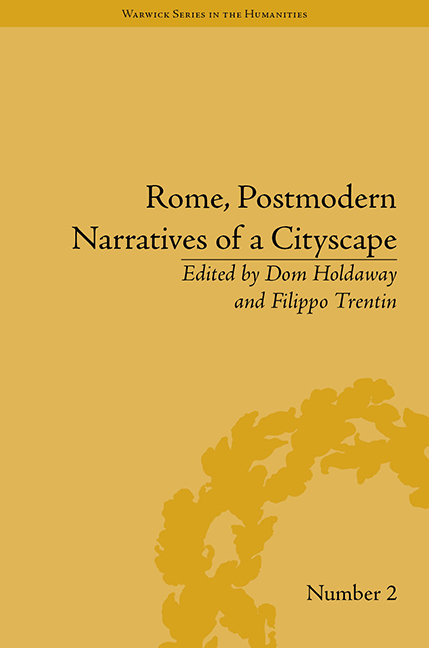Book contents
- Frontmatter
- Contents
- Acknowledgements
- List of Contributors
- List of Figures
- Introduction: Rome, Postmodern Narratives of a Cityscape
- Part I Knowing Rome
- 1 Between Rome's Walls: Notes on the Role and Reception of the Aurelian Walls
- 2 The Explosion of Rome in the Fragments of a Postmodern Iconography: Federico Fellini and the Forma Urbis
- 3 Centre, Hinterland and the Articulation of ‘Romanness’ in Recent Italian Film
- Part II Fragmented Topography
- Part III Situating Rome
- Notes
- Index
1 - Between Rome's Walls: Notes on the Role and Reception of the Aurelian Walls
from Part I - Knowing Rome
- Frontmatter
- Contents
- Acknowledgements
- List of Contributors
- List of Figures
- Introduction: Rome, Postmodern Narratives of a Cityscape
- Part I Knowing Rome
- 1 Between Rome's Walls: Notes on the Role and Reception of the Aurelian Walls
- 2 The Explosion of Rome in the Fragments of a Postmodern Iconography: Federico Fellini and the Forma Urbis
- 3 Centre, Hinterland and the Articulation of ‘Romanness’ in Recent Italian Film
- Part II Fragmented Topography
- Part III Situating Rome
- Notes
- Index
Summary
Le maree delle epoche sono passate e si sono ritirate lasciando sulla rena i relitti di lontani naufragi: come tutti i relitti, hanno attorno uno spazio prossimo e sconfinato, il mare e la spiaggia. È una città [Roma] vissuta di spoglie, poi di rovine, oggi di rifiuti.
(The tides of the ages rose and then fell, leaving behind on the sand the relics of distant shipwrecks: like all relics, they surrounded by close and unconfined space, the sea and the beach. [Rome] is a city lived of spoils, then of ruins, now of rubbish.)
G. C. Argan (1978)Introduction
At present Rome's urban space appears open and unconfined. The major housing expansion, which began during the post-war period and stretched through to the present, brought about a loss of coherency in the urban fabric. Over time, the city centre – while nominally preserved thanks to its historic value – has lost the specific, connecting function of ‘the centre’, becoming instead a discordant space. In its place, individual and disconnected fragments within the city have assumed its various ‘central functions’: be they administrative, economic, cultural, etc. Roberto Cassetti has commented on this situation, making particular reference to the 2003 piano regolatore, the urban master plan of the city. In Cassetti's view, the various ‘centres’ of Rome, which have materialized around the various focal points of urban activity, should be placed into dialogue with one another within a system of reciprocal relationships, so as to manage organically the dispersed urban context.
- Type
- Chapter
- Information
- Rome, Postmodern Narratives of a Cityscape , pp. 19 - 38Publisher: Pickering & ChattoFirst published in: 2014



